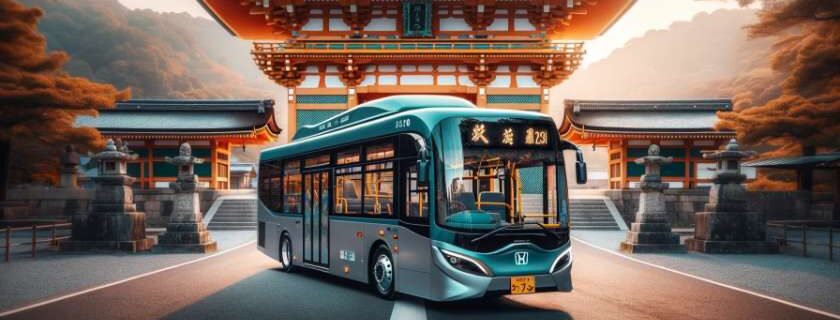
In the enchanting city of Kyoto, navigating its historical sites and cultural wonders is made easier with the efficient Kyoto bus system. Offering a convenient and affordable way to explore this ancient capital of Japan, the Kyoto bus network connects travelers to iconic landmarks like Kinkaku-ji Temple and Fushimi Inari Shrine. With roots dating back centuries, these buses not only provide transportation but also a glimpse into the rich history of Kyoto.
Discover how this modern mode of transport seamlessly blends with traditional surroundings, offering visitors a unique perspective on the city’s past while effortlessly moving through its vibrant present. Immerse yourself in Kyoto’s captivating charm as you hop aboard these buses, which serve as both time machines and portals to unforgettable experiences.
Key Takeaways
- Familiarize yourself with the Kyoto bus system to travel around the city conveniently.
- Understand bus maps to plan your routes efficiently and avoid getting lost.
- Use Kyoto City buses effectively by learning about routes, schedules, and fares.
- Follow tips for riding Kyoto City buses smoothly, such as preparing exact change and boarding etiquette.
- Consider utilizing discount passes and ticketing options to save money on multiple bus rides.
- Discover recommended destinations in Kyoto accessible by bus for a well-rounded travel experience.

Navigating Kyoto Bus System
Bus Types
Kyoto offers various bus types to cater to different needs, with one of the most popular being the Raku Bus 100. This particular route is not only convenient but also a favorite among tourists due to its strategic stops at major attractions throughout the city. If you’re looking for an efficient way to explore Kyoto’s beauty, hopping on the Raku Bus 100 might be your best bet.
- Pros:
- Convenient and popular among tourists
- Stops at major tourist attractions
- Ideal for exploring the city without missing key sights
Payment Process
There are multiple options available. You can opt for traditional cash payments directly onboard or utilize modern solutions like IC cards[1] such as Suica or Pasmo. The flexibility in payment methods means you don’t have to worry about purchasing tickets beforehand; simply choose what works best for you when boarding the bus.
- Cons:
- There are limited alternatives if you forget cash or IC card
- Some visitors may find using IC cards challenging initially
Fare Structure
Kyoto’s bus system operates on a fare structure that aims to be both simple and affordable for passengers. Most routes follow a flat fare system, making it easy for travelers regardless of their destination within the city. However, keep in mind that fares may vary based on how far you travel, ensuring fair pricing while still offering budget-friendly rates overall.
- Key Information:
- Flat fare system simplifies payments
- Fares depend on distance traveled
- Affordable prices suitable for all passengers
Operational Hours
The operational hours of Kyoto buses provide ample opportunities for exploration from early morning until late evening each day. While specific timings might differ depending on the route taken, rest assured that whether you’re an early riser eager to start your day or a night owl enjoying Kyoto’s evening ambiance, there will likely be a bus schedule accommodating your plans.
Understanding Bus Maps
Downloading Map
Bus maps for Kyoto can easily be obtained from official websites or apps. These maps are crucial, as they provide a clear overview of bus routes and stops. By having access to these maps, travelers can effectively plan their journey in advance, making it easier to navigate the city’s bus system.
Downloading bus maps is beneficial because it allows individuals to familiarize themselves with the various bus lines available in Kyoto. This knowledge helps passengers identify which buses to take based on their destination and preferred route. Understanding the bus network through these maps ensures a smoother and more efficient travel experience for visitors exploring Kyoto.
- Convenient access to bus routes
- Helps in pre-planning journeys
- Enables efficient navigation throughout the city
District Map
A district map offers an insightful glimpse into the different areas of Kyoto, highlighting key attractions within each district. Travelers can use this map to gain a better understanding of what each part of the city has to offer, aiding them in deciding which districts align with their interests or sightseeing preferences.
District maps serve as valuable tools when planning an itinerary, as they showcase popular landmarks and sights unique to specific areas in Kyoto. With this information at hand, tourists can prioritize visiting districts that appeal most to them, ensuring they make the most out of their time exploring the diverse cultural and historical offerings scattered across Kyoto.
- Provides an overview of distinct districts
- Highlights the main tourist attractions
- Assists travelers in choosing areas to visit
Route Map
The comprehensive route map displays all bus lines operating within Kyoto, along with details about stops along each route. This visual representation aids passengers by illustrating how different routes intersect and connect throughout the city, facilitating seamless navigation from one location to another via public transportation.
Route maps are essential resources for those looking to explore various parts of Kyoto using its extensive bus network efficiently. By studying these detailed maps before embarking on their journey, visitors can feel more confident navigating through unfamiliar streets while relying on public buses as a convenient mode of transportation during their stay.

Using Kyoto City Bus Effectively
Flat Fare Routes
Kyoto City Bus has flat fare routes where you pay the same amount no matter how far you go. This is perfect for short trips within a specific area, like hopping between nearby temples or shrines. These routes are great money-savers compared to variable fare options.
When using flat fare routes, consider visiting popular spots in close proximity, such as Gion District and Kiyomizu-dera Temple. With a fixed fee for each ride, exploring these areas becomes budget-friendly and hassle-free.
- Pros:
- Cost-effective for short distances
- Convenient for quick sightseeing tours
Non-Flat Fare Routes
On the other hand, non-flat fare routes calculate your fee based on the distance traveled. If you’re planning to visit attractions spread across different parts of Kyoto, this option might be more suitable. The longer your journey, the higher the fare will be due to increasing distance coverage.
For longer journeys around Kyoto that involve traveling from one end of the city to another, non-flat fare routes provide flexibility but may cost more than flat-rate options in certain scenarios.
- Cons:
- More expensive for extended travels
- Pricing varies depending on distance covered
Day Pass Tickets
If you’re looking to explore multiple sites in a day without worrying about individual fares, consider purchasing day pass tickets offered by Kyoto City Bus. These tickets allow unlimited rides within a day at a fixed price point. They are available at ticket vending machines located at major bus stops or information centers throughout the city.
Day passes can be an excellent choice when planning an itinerary with several locations on your agenda: think Fushimi Inari Taisha Shrine in the morning followed by Arashiyama Bamboo Grove later in the day—all covered under one cost-efficient daily pass!
- Purchase day pass tickets from designated vending machines.
- Enjoy unlimited bus rides throughout Kyoto within a single day.
- Make sure to validate your ticket upon boarding each bus during your explorations.
Tips for Riding Kyoto City Bus
Boarding Process
When taking the Kyoto bus, make sure to wait at the designated stops for your desired route. Once the bus arrives, queue up and board promptly. Remember to show your ticket or IC card to the driver as you enter.
Boarding a bus in Kyoto is simple; just be attentive to your surroundings, follow the line, and have your fare ready. This way, you can ensure a smooth boarding process without any delays.
Getting Off
To get off at your stop, press the stop button or pull the cord before reaching it. Exit through the rear door of the bus smoothly and efficiently. Always consider other passengers while disembarking by moving swiftly but politely.
When getting off a crowded Kyoto city bus, signaling ahead of time helps both you and other passengers prepare for stops effectively. By doing so, you contribute to maintaining an orderly flow during exits.
Basic Manners
Practice good manners on Kyoto buses by offering your seat to elderly or disabled individuals when needed. Keep noise levels low during rides and refrain from engaging in phone conversations inside buses. Dispose of trash correctly in the provided bins within buses; this ensures cleanliness onboard for all passengers throughout their journey.
Discount Passes And Ticketing
Discount Passes
Tourists in Kyoto can benefit from various discount passes when using the city bus. These passes typically offer discounted fares or unlimited rides, catering to different travel needs. For example, the Kyoto City Bus and Subway Pass provides unlimited rides on both modes of transportation for a set number of days, making it convenient for visitors exploring various attractions across the city. It’s essential to check for specific passes that align with your itinerary to maximize savings during your stay.
When utilizing these discount passes, travelers can enjoy cost-effective transportation solutions while navigating Kyoto’s diverse cultural landmarks and scenic spots conveniently. By selecting a pass that suits their intended destinations and duration of stay, tourists can streamline their travel expenses and make the most out of their sightseeing adventures without worrying about individual ticket costs.
Ticket Fares
In Kyoto, bus ticket fares are determined by the distance traveled, ensuring that passengers pay accordingly based on their journey length. The city’s bus system offers affordable prices compared to other modes of transport like taxis, providing an economical way for locals and visitors alike to move around efficiently. When paying in cash onboard, having exact change is appreciated, as it helps speed up boarding processes and ensures smooth transactions between passengers and drivers.
The flexibility offered by varied fare options allows commuters to choose routes based on affordability while enjoying a comfortable ride through Kyoto’s bustling streets or serene neighborhoods. With transparent pricing structures in place, passengers can plan their budgets effectively when incorporating bus travel into their daily commutes or sightseeing plans within the city.

Recommended Destinations
Explore Scenic Areas In North West Kyoto
If you’re in Kyoto and looking for breathtaking sightseeing locations, consider heading to the northwest part of the city. Here, you can immerse yourself in the beauty of places like Arashiyama and Kinkakuji Temple. Arashiyama is famous for its stunning bamboo groves, which create a serene atmosphere. The area also boasts historic temples where you can explore Japan’s rich cultural heritage.
Conveniently, there are bus routes that connect these attractions, making it easy for tourists to navigate between them without hassle. Whether you want to stroll through picturesque gardens or marvel at ancient architecture, North West Kyoto offers a blend of natural beauty and cultural richness that will leave a lasting impression on your visit.
- Pros:
- Accessible bus routes connecting major attractions
- Rich cultural experiences with historic temples
- Scenic views, including beautiful bamboo groves
- Cons:
- Popular tourist spots may get crowded during peak seasons
Visit The Charming Ohara
For those seeking tranquility away from the bustling city life, Ohara is an ideal destination to explore while in Kyoto. This charming rural area is known for its peaceful ambiance and natural beauty. Buses provide convenient transportation options to reach this serene destination, allowing visitors to escape into a world of serenity.
In Ohara, you’ll discover hidden gems such as peaceful temples nestled amidst lush greenery. The tranquil surroundings offer a perfect retreat from urban chaos, providing an opportunity to relax and rejuvenate while immersing yourself in Japan’s spiritual heritage.
Hotels and Accommodations
Near Kyoto Station
If you’re staying near Kyoto Station, utilizing the bus routes can be a convenient way to get around. These buses are designed to connect with major tourist spots and various accommodations, making it easier for travelers who have just arrived by train. For instance, if you’re heading to the famous Kiyomizu-dera Temple or Gion district from Kyoto Station, hopping on one of these buses can save you time and effort.
When considering taking the bus from Kyoto Station, keep in mind that during peak hours, these buses tend to get crowded quickly. To ensure you secure a seat and avoid standing for an extended period, it’s advisable to check the availability of seats before boarding. If you find that the buses are full or too crowded for your liking, exploring alternative routes or adjusting your travel timings could be beneficial.
Checking Availability
One advantage of using bus services near Kyoto Station is their ability to efficiently transport passengers to various destinations within the city. However, a potential downside is that these buses may become overcrowded during specific times of the day when commuters are traveling back home after work or tourists are moving between attractions. It’s essential for travelers relying on these services to plan ahead by checking seat availability beforehand.
In situations where buses appear packed or unavailable due to high demand, consider looking into other transportation options like taxis or trains as alternatives. Adjusting your schedule slightly earlier or later than rush hours might help in securing a more comfortable journey without having to deal with overcrowded vehicles.
Alternatives to Taking the Bus
Subway Information
Kyoto’s subway system serves as an efficient alternative to Kyoto bus transportation. The city boasts two subway lines, the Karasuma Line and the Tozai Line, covering various areas of Kyoto. Travelers can rely on the subway for faster journeys over longer distances.
Subway Pros:
- Quick transportation for longer distances
- Covers different parts of Kyoto effectively
Subway Cons:
- Limited reach compared to buses
For instance, if you’re staying in a hotel near Kyoto Station and plan to visit attractions like Fushimi Inari Taisha Shrine in Southern Kyoto, taking the subway can be a time-saving option.
Other Transport Options
In addition to subways and buses, Kyoto provides several other transport options, such as taxis, bicycles, and rental cars. When deciding which mode of transport suits your needs best, consider factors like cost-effectiveness, convenience, and accessibility.
Transport Options Overview:
- Taxis: Ideal for quick point-to-point travel but can be costly.
- Bicycles: Great for exploring at your own pace while enjoying scenic routes.
- Rental Cars: Offer flexibility in itinerary planning but require navigation skills.
Each mode has its advantages based on individual preferences; for example, renting a bicycle might offer a more immersive experience when visiting cultural sites like Kinkaku-ji (Golden Pavilion) or Arashiyama Bamboo Grove.

Essential Travel Checklist
Vacation Checklist
When exploring Kyoto, Kyoto buses are a convenient way to navigate the city. To ensure a smooth trip, plan your itinerary ahead of time. Checking bus schedules and routes in advance can help you efficiently move around the city without wasting time waiting for buses. Don’t forget to pack essentials like comfortable shoes to walk around easily, a map to navigate through different stops, and an umbrella for unexpected weather changes.
Information centers in Kyoto play a crucial role in assisting tourists with bus routes and fares. These centers are staffed with knowledgeable individuals who can provide valuable tourist information and recommendations. If you’re unsure about which bus route to take or need guidance on planning your day’s activities, the friendly staff at these information centers will be more than happy to help you out. It’s advisable to locate these information centers strategically across key areas of Kyoto for easy access when needed.
Information Centers
- Information centers offer assistance with bus routes and fares
- Staff provide valuable tourist information and recommendations
- Locate information centers strategically across key areas of Kyoto
You’ve now mastered the ins and outs of navigating Kyoto’s bustling bus system. Understanding bus maps, utilizing city buses effectively, and picking up handy tips along the way have transformed you into a savvy traveler. From discount passes to recommended destinations, hotels, and alternatives to buses, you’re all set for an unforgettable Kyoto adventure. Remember your travel checklist, hop on that bus, and let Kyoto’s charm sweep you off your feet!
Explore Kyoto with confidence, armed with your newfound knowledge. Get ready to immerse yourself in the beauty of this historic city while effortlessly hopping from one destination to another. Your Kyoto journey awaits—go out there and make unforgettable memories!
Frequently Asked Questions
How can I navigate the Kyoto bus system effectively?
To navigate the Kyoto bus system effectively, study bus maps beforehand, understand routes and schedules, use smartphone apps for real-time information, and consider purchasing a day pass for unlimited rides.
What are some tips for riding the Kyoto City Bus?
When riding the Kyoto City Bus, have your fare ready in exact change or use an IC card. Board from the rear door and exit from the front. Pay attention to announcements and digital displays for upcoming stops.
Are there any discount passes available for using Kyoto buses?
Yes, there are various discount passes available, such as one-day or two-day unlimited ride passes. These can offer substantial savings if you plan on using public transportation frequently during your stay in Kyoto.
What are some recommended destinations accessible by bus in Kyoto?
Popular destinations accessible by bus in Kyoto include Kinkaku-ji (Golden Pavilion), Fushimi Inari Taisha Shrine, Arashiyama Bamboo Grove, Gion District, Nijo Castle, and Kiyomizu-dera Temple, among others.
What alternatives exist to taking the bus while exploring Kyoto?
Apart from buses, alternative transportation options in Kyoto include taxis for convenience but at a higher cost; bicycles, which provide flexibility and exercise; and walking tours, ideal for exploring specific districts leisurely.




